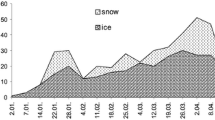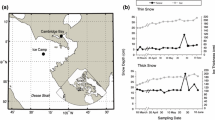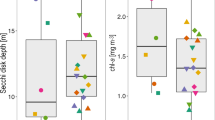Abstract
In an attempt to assess bacterioplankton production and growth yieldunder low temperature conditions and to compare bacterioplankton withphytoplankton production in the ice-covered water column of the shallowNeusiedler See, outdoor measurements under near in situ conditions wereperformed during the winter of 1995/96. During the investigation period,mean chlorophyll (Chl) a concentration was 21.03 ± 14.95 µg Chla l-1. Phytoplankton primary production integrated over thewater column ranged from 1.35 to production integrated over the water columnranged from 1.35 to 4.23 mg C m-2 d-1 (mean± SD = 2.46 ± 1.06 mg C m-2d-1). Bacterial abundance varied from 20 to 40×105 ml-1 for most of the investigationperiod and increased by the end of March concomitantly with the increase intemperature from 1.3 to 6.3 °C within 5 days. Mean bacterial productionwas 15.3 ± 12.8 µg C l-1 d-1(range: 3.0 to 41.7 µg C l-1 d-1) and meanbacterial growth rate 0.23 ± 0.16 d-1 following closelythe pattern in bacterial production. DOC concentration declined linearlyfrom 20.7 mg C l-1 to 16.45 mg C l-1 over the 4months period of ice cover. The contribution of humic substances to thetotal DOC pool declined from 43.6% at the end of November to37.3% at the end of March. Calculated on an area basis, phytoplanktonproduction amounted to only 16% of bacterial production which makesit unlikely that phytoplankton supply substrate for bacterioplankton growthin significant quantities when the lake is ice covered. From the observeddecline in DOC over the investigation period and assuming only negligibleinput of DOC from other sources we calculated an average DOC uptake by thebacterioplankton community of 47.5 µg C l-1d-1 resulting in a bacterial growth efficiency of 15.9%for the ice covered conditions. Based on the growth efficiency we estimatethat pelagic primary production amounts to 2.8% of the bacterialcarbon demand. This might indicate that the bacterioplankton in NeusiedlerSee sustain their high growth rates at low temperatures (<2°C formost of the investigation period) by using probably the DOC originating fromthe previous season. This DOM stems most likely from the decay of the reedPhragmites australis and its epiphytes and, probably of minor importance,from phytoplankton leachates.
Similar content being viewed by others
References
Aiken, G. R., 1985. Isolation and concentration techniques for aquatic humic substances. In Aiken, G. R., D. M. McKnight & R. L. Wershaw (eds), Humic Substances in Soil, Sediment, and Water, Geochemistry, Isolation, and Characterization, John Wiley & Sons, New York: 363-383.
Amon, R. M. W. & R. Benner, 1996. Bacterial utilization of different size classes of dissolved organic matter. Limnol. Oceanogr. 41: 41-51.
Benner, R. & M. Strom, 1993. A critical evaluation of the analytical blank associated with DOC measurements by high-temperature catalytic oxidation. Mar. Chem. 41: 153-160.
Berger, B., B. Hoch, G. Kavka & G. J. Herndl, 1995. Bacterial Metabolism in the River Danube: parameters influencing bacterial production. Freshwat. Biol. 34: 601-616.
Biddanda, B., S. Opsahl & R. Benner, 1994. Plankton respiration and carbon flux through bacterioplankton on the Louisiana shelf. Limnol. Oceanogr. 39: 1259-1275.
Bjørnsen, P. K., 1986. Bacterioplankton growth yield in continuous seawater cultures. Mar. Ecol. Prog. Ser. 30: 191-196.
Chin-Leo, G. & R. Benner, 1992. Enhanced bacterioplankton production and respiration at intermediate salinities in the Mississippi River plume. Mar. Ecol. Prog. Ser. 87: 87-103.
Cole, J. J., S. Findlay & M. L. Pace, 1988. Bacterial production in fresh and saltwater ecosystems: a cross-system overview. Mar. Ecol. Prog. Ser. 43: 1-10.
Cole, J. J. & M. L. Pace, 1995. Whymeasure bacterial production? A reply to the comment by Jahnke and Craven. Limnol. Oceanogr. 40: 441-444.
Coveney, M. F. & R. G. Wetzel, 1995. Biomass, production, and specific growth rate of bacterioplankton and coupling to phytoplankton in an oligotrophic lake. Limnol. Oceanogr. 40: 1187- 1200.
Dokulil, M., 1975. Bacteria in the water and mud of Neusiedler See (Austria). Symp. Biol. Hung. 15: 135-140.
Dokulil, M., 1984. Assessment of components controlling phytoplankton photosynthesis and bacterioplankton production in a shallow, alkaline, turbid lake (Neusiedlersee, Austria). Int. Rev. ges. Hydrobiol. 69: 679-727.
Felip, M., B. Sattler, R. Psenner & J. Catalan, 1995. Highly active microbial communities in the ice and snow cover of high mountain lakes. Appl. envir. Microbiol. 61: 2394-2401.
Felip, M., M. L. Pace & J. J. Cole, 1996. Regulation of planktonic bacterial growth rates: the effects of temperature and resources. Microbiol. Ecol. 31: 15-28.
Fuhrman, J. A. & F. Azam, 1982. Thymidine incorporation as a measure of heterotrophic bacterioplankton production in marine surface waters: evaluation and field results. Mar. Biol. 66: 109- 120.
Griffith, P. C., D. J. Douglas & S. C. Wainright, 1990. Metabolic activity of size-fractionated microbial plankton in estuarine, nearshore, and continental shelf waters of Georgia. Mar. Ecol. Prog. Ser. 59: 263-270.
Hejzlar, J., B. Szpakowska & R. L. Wershaw, 1994. Comparison of humic substances isolated from peatbog water by sorption on DEAE-cellulose and Amberlite XAD-2. Wat. Res. 28: 1961- 1970.
Lee, S. & J. A. Fuhrman, 1987. Relationships between biovolume and biomass of naturally derived marine bacterioplankton. Appl. envir. Microbiol. 53: 1298-1303.
Löffler, H., 1979. Neusiedler See: The limnology of a shallow lake in central Europe. Dr W Junk Publishers, The Hague, 543 pp.
Moran, M. A. & R. E. Hodson, 1990. Bacterial production on humic and nonhumic components of dissolved organic carbon. Limnol. Oceanogr. 35: 1744-1756.
Parsons, T., Y. Maita & C. Lalli, 1984. A Manual of Chemical and Biological Methods for Seawater Analysis. Pergamon Press, Oxford, 173 pp.
Pomeroy, L. R. & D. Deibel, 1986. Temperature regulation of bacterial activity during the spring bloom in Newfoundland coastal waters. Science 233: 359-361.
Pomeroy, L. R., S. A. Macko, P. H. Ostrom & J. Dunphy, 1990. The microbial food web in Arctic seawater: concentration of dissolved free amino acids and bacterial abundance and activity in the Arctic Ocean and in Resolute Passage. Mar. Ecol. Prog. Ser. 61: 31-40.
Pomeroy, L. R., J. E. Sheldon, W. M. S. Jr. & F. Peters, 1995. Limits to growth and respiration of bacterioplankton in the Gulf of Mexico. Mar. Ecol. Prog. Ser. 117: 259-268.
Pomeroy, L. R., J. E. Sheldon & J. W. M. Sheldon, 1994. Changes in bacterial numbers and leucine assimilation during estimations of the microbial respiratory rates in seawater by the precision Winkler method. Appl. envir. Microbiol. 60: 328-332.
Porter, K. G. & Y. S. Feig, 1980. The use of DAPI for identifying and counting aquatic microflora. Limnol. Oceanogr. 25: 943-948.
Reitner, B., A. Herzig & G. J. Herndl, 1997. Role of ultraviolet-B radiation on photochemical and microbial oxygen consumption in a humic-rich shallow lake. Limnol. Oceanogr. 42.
Rivkin, R. B., M. R. Anderson & C. Lajzerowicz, 1996. Microbial processes in cold oceans. I. Relationship between temperature and bacterial growth rate. Aquat. Microb. Ecol. 10: 243-254.
Scavia, D. & G. A. Laird, 1987. Bacterioplankton in Lake Michigan: dynamics, controls, and significance to carbon flux. Limnol. Oceanogr. 32: 1017-1033.
Schwaerter, S., M. Sondergaard, B. Riemann & L. M. Jensen, 1988. Respiration in eutrophic lakes: the contribution of bacterioplankton and bacterial growth yield. J. Plankton Res. 10: 515-531.
Simon, M. & M. M. Tilzer, 1987. Bacterial response to seasonal changes in primary production and phytoplankton biomass in Lake Constance. J. Plankton Res. 9: 535-552.
Slater, J. H., 1979. Principles of microbial behavior in ecosystems. In Lynch, J. M. & N. J. Poole (eds), Microbial Ecology, a Conceptual Approach, Blackwell, Oxford: 5-63.
Wetzel, R. G., 1992. Gradient-dominated ecosystems: sources and regulatory functions of dissolved organic matter in freshwater ecosystems. Hydrobiologia 229: 181-198.
Wiebe, W. J., W. M. Sheldon & L. R. Pomeroy, 1992. Bacterial growth in the cold: evidence for an enhanced substrate requirement. Appl. envir. Microbiol. 58: 359-364.
Wiebe, W. J., W. M. Sheldon & L. R. Pomeroy, 1993. Evidence for an enhanced substrate requirement by marine mesophilic bacterial isolates at minimal growth temperatures. Microbiol. Ecol. 25: 151-159.
Author information
Authors and Affiliations
Rights and permissions
About this article
Cite this article
Reitner, B., Herzig, A. & Herndl, G.J. Microbial activity under the ice cover of the shallow Neusiedler See (Austria, Central Europe). Hydrobiologia 357, 173–184 (1997). https://doi.org/10.1023/A:1003151323756
Issue Date:
DOI: https://doi.org/10.1023/A:1003151323756




